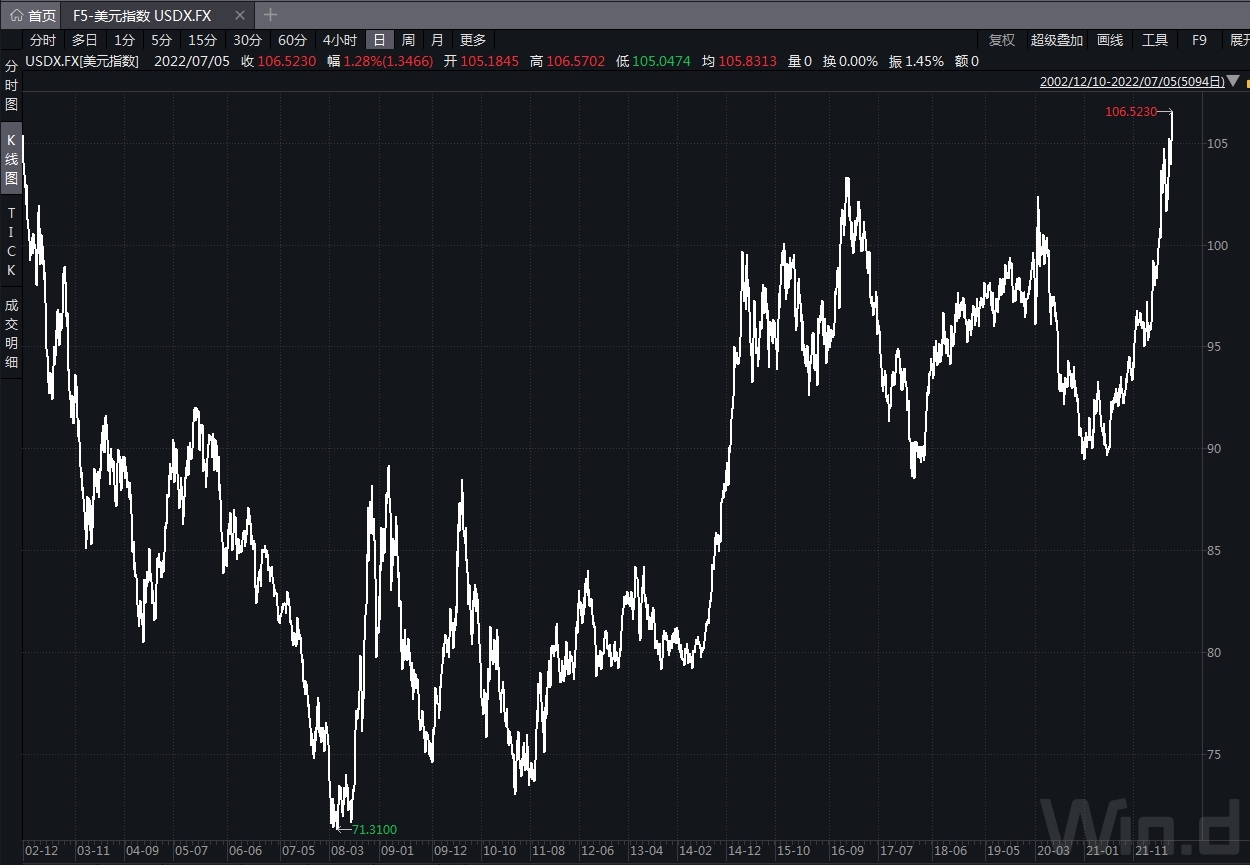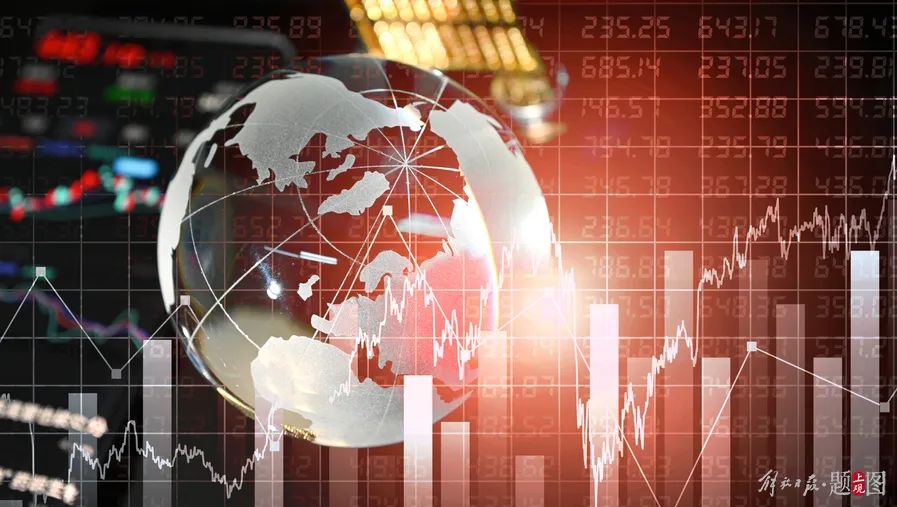The US dollar index strongly exceeded 106 euros to the US dollar to nearly 20 years low
Author:Daily Economic News Time:2022.07.05
On July 5th, Beijing time, the US dollar index reached 106.27 at the time of the deadline, a new high since 2003. At the same time, the euro against the US dollar fell significantly again. Beijing time was reported at 1.0281 at 17:49, down to the level of 2002.
Jin Tian, a senior researcher at the Digital Economic Research Institute of Zhongnan University of Economics and Law, said in an interview with the reporter of "Daily Economic News" that the exchange rate of the euro against the US dollar was declining, the important reason is that the market's interest rate hike expectations of the two currencies are different.
According to the latest data, the final value of Markit comprehensive PMI in the euro zone fell from 54.8 in May to 52 in June, a 16 -month low. In addition, the EU Statistical Bureau announced that the core CPI of the euro zone in June was 3.7%, and the same period last year was 0.9%.

US dollar index trend picture source: Wind
The euro against the US dollar continues to depreciate
While the US dollar index was stabilized by 106, the euro has fallen against the US dollar to a low point in nearly 20 years since 2003.
In an interview with "Daily Economic News", Jin Tian pointed out that the important reason for the decline in the exchange rate of the euro against the US dollar is that the market's interest rate hike expectations of the two currencies are different.
Jin Tian said that the US dollar is still in the process of interest rate hikes, and European and Ukraine's geopolitics such as Russia and Ukraine have directly affected, the risk of economic recession has risen, and the currency market has greatly reduced the betting of the European Central Bank this year. The difference between the two places is large, so compared to the strong performance of the dollar, the euro direction will be weak.

Euro against the US dollar trend picture Source: Wind
The Federal Reserve Commission announced on June 15 that the 75 -basis point of interest rate hikes raised the federal fund interest rate target range to 1.5%to 1.75%. This is the Federal Reserve's maximum rate hike since 1994.
On July 26-27, Washington time, the Fed will hold a interest conference. The market generally estimates that 75 basis points to raise interest rates again are a high probability event.
The latest "Global Economic and Financial Outlook Report" of the Bank of China Research Institute pointed out that according to the Fed's latest point of view prediction, the federal fund interest rate may reach 3.25%-3.5%at the end of 2022, and the Federal Reserve's balance sheet may be reduced by the end of 2023 reduction About $ 1.5 trillion.
The report pointed out that in the second quarter of 2022, due to the tightening of monetary policy and affected by risk aversion, the US dollar index continued to appreciate, with a quarterly increase of approximately 6.7%. The currency of other developed economies weakened. Although the European Central Bank clearly released the interest rate hike signal for the first time, the economic and financial cycle of the euro zone was still lagging behind the United States. The exchange rate of the euro against the US dollar depreciated by 5.4%, which was close to the parity.
The report proposes that the US dollar index will continue to lower the cost of import. It is expected that the trade deficit will narrow and the negative dragging effect on the economy will decline.
The World Bank lowered global economic growth in 2022 to 2.9%. The above -mentioned listing report believes that the long growth and high inflation have brought investors to various safe -haven assets, including gold, US debt and US dollars. From April to May, the investment portfolio of emerging market securities continued to flow out, with a total of $ 8.9 billion.
Regarding the future trend of the US dollar, the above -mentioned outlook report states that the global economy is weak, the Fed's monetary policy accelerates tightening, and the US dollar index will maintain a relatively high level. However, as the risk of "stagnation" in the United States increases and the euro area withdraws from negative interest rates, the US dollar index will be under pressure. The euro exchange rate will rise steadily. The European Central Bank has gradually canceled the purchase of debts and launched the interest rate hike process, which will support the euro exchange rate. Russia and Ukraine conflicts are uncertain, and member states within the euro zone recovery and differentiation may cause certain disturbances.
The contribution rate of energy to the euro zone is more than 50 % or more
Turn your eyes to the EU. Since the beginning of this year, the Russian -Ukraine conflict has been under tremendous pressure on the European economy. Earlier, the European Commission stated that the current situation is full of extreme uncertainty, high downlink risk, conflict upgrade, energy supply stop, and further slowing economic growth in China and the United States may lead In 2022, the economic growth rate will drop to 0.2%, and the three quarters will continue to decline and fall into decline.
The "European Economic Outlook Report" released by the International Monetary Fund (IMF) predicts that the growth rate of domestic GDP (GDP) of developed economies and emerging economies in 2022 will drop to 3%and 3.2%, respectively, compared with The forecasts released in January this year dropped by 1 and 1.5 percentage points, respectively. The report pointed out that the Ukraine crisis has caused serious economic consequences to Europe. The sharp rise in commodity prices and the problem of natural gas supply will further intensify inflation and reduce European household income and corporate profits.
According to the EU Statistical Bureau, the core CPI of the euro zone in June was 3.7%, and the same period last year was 0.9%. The final value of Markit comprehensive PMI in the euro zone fell from 54.8 in May to 52 in June, a 16 -month low. Market analysis believes that the downlink risks of European economy have increased significantly, inflation risks are increasing, and the significant rise in energy prices is the main reason for high inflation at this stage. At present, about 45%of natural gas, 27%of oil, and 46%of coal from EU imports come from Russia. Russian energy plays an important role in the EU energy consumer market and economic development.
The Global Economic and Financial Outlook Report states that since April 2021, the contribution rate of energy to the euro zone inflation has been more than 50%, and the contribution rate in May 2022 is 53%. The above -mentioned listing report analysis, with the EU officially approved the sixth round of sanctions against Russia in June, the European Union will gradually stop the purchase of Russian crude oil through maritime transportation. It is expected that by the end of 2022, the EU's oil imported from Russia will be reduced by 90%. The outlook report judged that the European Union and Russia's energy decoupling were difficult to achieve overnight. In the short term, there was still risk of imbalance in natural gas supply and demand, which will once again push the price of natural gas.
The list mentioned that the euro zone has a high dependence on Russia. At present, Poland, Bulgaria, Finland, the Netherlands and other countries are facing the threat of Russia's air breach, and the price of natural gas in the euro zone has risen sharply. In the third quarter, European countries will reserve for the shortage of energy in winter. Energy prices may continue to rise. Even if the central bank of the euro zone officially launched interest rate hikes in July and September, inflation may continue to rise, especially relying on Russia's natural gas imports or facing ventilation. The threats of Germany, Italy, Austria, Hungary, Slovakia, Czech Republic, Bulgaria, Poland and other countries have greater pressure on inflation.
The above -mentioned listing report judged that with the evolution of the situation in Russia and Ukraine, the effects of sanctions and anti -sanctions infection spread, the European energy gaps made up heavy resistance. The European energy market will face severe turbulence. The use of structural changes in energy types, games between supplying countries, replacement and regression of traditional energy and green energy will be a problem that plagues the government, market, and residents.
Daily Economic News
- END -
Shanghai's GDP in the first half of the year fell 5.7%: the impact was unprecedented before, and rebounded quickly in June

On the 18th, the Shanghai Municipal Bureau of Statistics released data. In the fir...
Cultural Tourism Style Standard | Exclusive In -depth Research: State Cultural Industrial Park Construction Trends

A few days ago, the Ministry of Culture and Tourism issued the Opinions on Promoti...